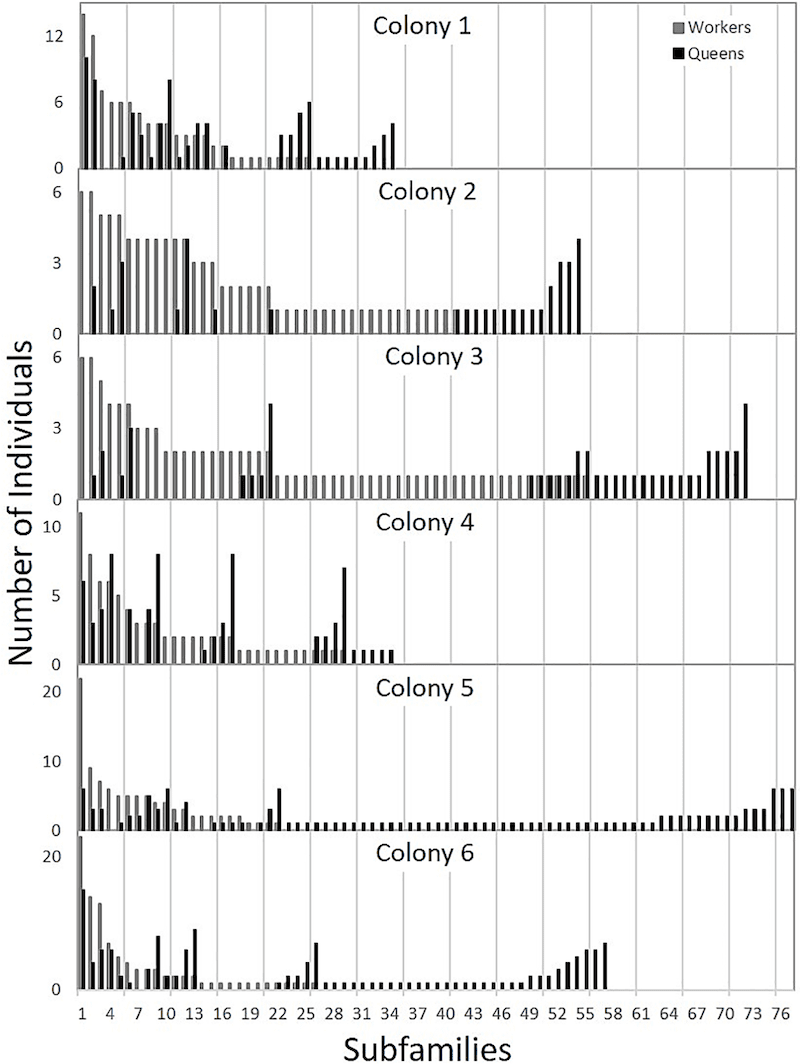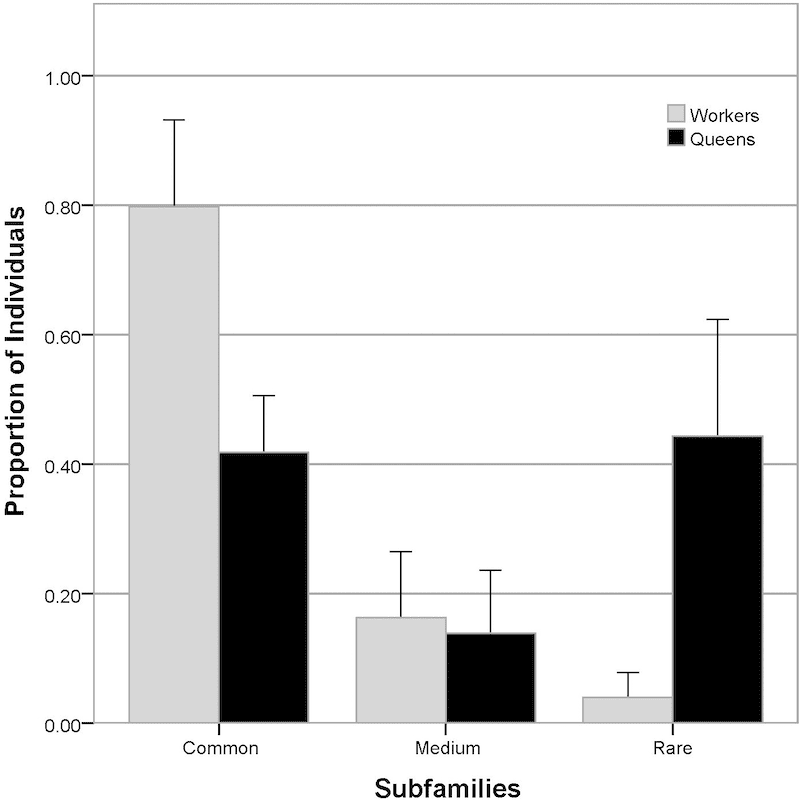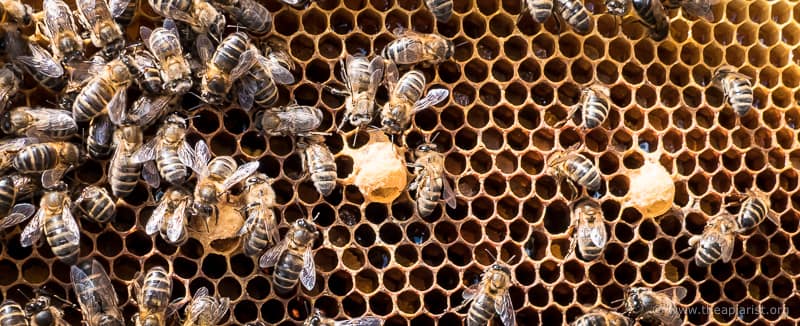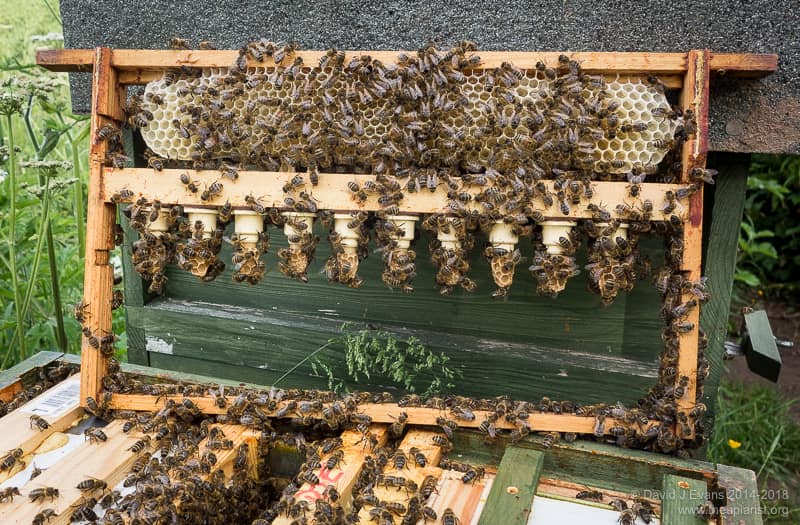Who's the daddy?
I’ve recently discussed the importance and influence of polyandry for honey bee colonies. Briefly, polyandry – the mating of the queen with multiple (~12-18) drones – is critical for colony fitness e.g. ability to resist disease, forage efficiently or overwinter successfully.
Hyperpolyandry, for example resulting from instrumental insemination of the queen with sperm from 30+ drones, further increases colony fitness and disease resistance.
How do you measure polyandry?
Essentially, you genetically analyse the worker bees in the colony to determine the range of patrilines present. Patrilines are genetically distinct offspring fathered by different drones. Essentially they are subfamilies within the colony.
With a finite number of patrilines – which there must be, because the queen does not mate with an infinite number of drones – there will be a point at which the more workers you screen the fewer new patrilines will be detected.
The more you screen, the more you are likely to have detected all the patrilines present.
However, the queen uses sperm randomly when fertilising worker eggs. This compounds the difficulty in determining the full range of different patrilines present in a population. In particular, it makes detecting very rare patrilines difficult.
For example, if 20% of workers belong to one patriline you don’t need to sample many bees to detect it. In contrast, if another patriline is represented by 0.0001% of randomly selected workers you would probably have to screen thousands to be sure of detecting it.
Consequently, rare patrilines in the honey bee worker population are very difficult to detect. Inevitably this means that the number of drones the queen mates (~12-18) with is probably an underestimate of the actual number {{1}}.
Half-sisters and super-sisters
Worker bees are often described as ‘half sisters’ to each other. They share the same mother (the queen), but different fathers.
Actually, as you should now realise, that’s an oversimplification because – with only ~12-18 different fathers contributing to the genetics of the colony – some workers are going to be more related to each other because they share the same father and mother.
Half-sisters share the same mother but have different fathers and share about 25% of their genes.
Super-sisters share the same mother and father and so share about 75% of their genes (25% from the queen and 50% from the drone).
Super-sisters are more likely to help each other in the colony {{2}}.
Emergency queens and nepotism
What’s the most important decision a colony makes?
If the queen is killed (or removed) the workers rear new queens under the so-called ’emergency response’. They feed selected young larvae copious amounts of Royal Jelly to rear a replacement queen.
Arguably, the most important decision the workers make is the selection of the day-old larvae to rear as new queens.
If they get it wrong the colony is doomed. If they get it right the colony will flourish {{3}}.
But as described above, workers are more or less related to each other genetically.
To ensure the continued propagation of at least some of their genes it might be expected that the nurse bees making this selection {{4}} would choose larvae more closely related to themselves.
Do worker bees exhibit nepotism when rearing emergency queens?
If workers were nepotistic you’d expect the most common patrilines in the nurse/worker bee population would also predominate in the queens reared.
However, for at least 20 years evidence has been accumulating that indicates bees are not nepotistic. On the contrary, emergency queens appear to be reared from some of the rare patrilines in the colony.
A recent paper from James Withrow and David Tarpy has provided some of the best evidence for the existence of these so-called royal patrilines in honey bee colonies {{5}}.
Royal patrilines
Evidence for these goes back to at least 1997 {{6}}, with about half a dozen publications in the intervening period. Essentially all used broadly the same approach; they genetically screened worker bees and the emergency queens they reared to determine which patrilines were present in the two groups.
With certain caveats (size of study, number of microsatellites screened, colony numbers etc.) all concluded that colonies rear emergency queens from some of the rarest patrilines in the colony.
The recent study by Withrow and Tarpy is well explained and probably the most comprehensive, so I’ll use that to flesh out the details.
Experimental details
Six double-brood colonies were each split into a three separate colonies; a queenright single-brood colony and two five-frame nucs. The latter contained eggs and young larvae and so reared emergency queens.
Seven days later the developing emergency queens were all harvested for future analysis. One or two frames from the nucs were then exchanged with frames containing eggs and day-old larvae from the matched queenright colony.
The nucs then started rearing new queens … again.
And again … and again.
This process was repeated until the nucs failed.
In total over 500 queens were reared (to 7 days old) from these six original colonies. These queens were analysed genetically by microsatellite analysis, as were over 500 workers from colonies.
Within the 6 experimental colonies the authors identified a total of 327 patrilines (or subfamilies as Withrow and Tarpy describe them), ranging from 34-77 per colony. 108 patrilines (4-40 per colony) were exclusively detected in worker bees and 130 patrilines (5-55/colony) were exclusively detected in queens.
Cryptic “royal” subfamilies
Over 40% of queens raised per colony were produced from the patrilines exclusively detected in the queen population.
As shown in the figure above, many queens (black bars) were reared from subfamilies (patrilines) not represented in the worker bee population (grey bars, sorted left to right by abundance).
Since there were different numbers of patrilines per colony (34-77), the bias towards the rarer patrilines is more apparent if you instead split them into tertiles (thirds) based upon worker abundance.
Are the queens predominantly reared from the most common tertile, the intermediate tertile or the rarest tertile?
It’s very clear from this graph that workers select queens from the rarest patrilines within the colony.
It is therefore very clear that worker bees do not exhibit nepotism when choosing which larvae to rear emergency queen from.
Implications for our understanding of honey bee reproduction
Two points are immediately apparent:
- there is a cryptic population of queen-biased patrilines that have largely been overlooked in genetic studies of honey bee polyandry
- honey bee queens mate with more drones than conventional studies of worker bee patrilines indicate
Colony 5 had at least 77 distinct subfamilies (there might have been more detected had they screened more than the 94 workers and 135 queens from this colony). By extrapolation it is possible to determine that the effective queen mating frequency (me; the number of drones the queen had mated with) was ~32 if all the samples (worker and queen) were taken into account. If only the worker or queen samples were used for this calculation the effective queen mating frequency would be ~12 or ~65 respectively.
The average effective queen mating frequency over the six colonies was ~33 (total), significantly higher than the oft-quoted (including at the top of this page) me of ~12-18.
So perhaps honey bees really are hyperpolyandrous … or even extremely hyperpolyandrous as the authors suggest.
It’s worth noting in passing that routine mating frequencies over 30 are almost never quoted for honey bees {{7}}, but that the ‘normal’ me ~12-18 is rather low when compared with other species within the genus Apis. The giant honey bee, Apis dorsata, exhibits mating frequencies of greater than 60.
Who’s the daddy?
So, when it comes to emergency queens , although we might not know precisely who the daddy is, we can be pretty certain the particular patriline selected by the workers is most likely to be one of the rare ones in the colony.
Mechanistically, what accounts for this?
Are these larvae selected solely because they are rare?
That seems unlikely, not least because it would require some sort of surveying or screening by nurse bees. Not impossible perhaps, though I’m not sure how this would be achieved.
Perhaps it is not even worker selection?
An alternative way to view it is larval competition. A better competing larvae would be fed Royal Jelly and would be much more likely to pass on her genes to the next generation.
We don’t know the answers to these questions … yet.
Or whether they’re the wrong questions entirely.
Swarming and supercedure
The colony rears a new queen under three conditions; enforced queenlessness (as described above) which induces emergency queen rearing, prior to swarming and during supersedure.
These are fundamentally different processes in terms of the larvae used for queen rearing.
During swarming and supersedure {{8}} the queen lays the egg in a ‘play cup’ which is subsequently engineered into a queen cell in which the new queen develops.
However, it is known that the patrilines of queens reared during the swarming response are similar to those of workers in the same colony {{9}}, implying that there is no overt selection by the workers (or the parental queen).
Queen rearing
Does this insight into how bees rear new queens have any implications for how beekeepers rear new queens?
There are about as many queen rearing methods as there are adult workers in a double-brood colony in late June. Many exploit the emergency queen rearing response by a colony rendered temporarily or permanently queenless.
Beekeepers often comment on the differential ‘take’ of grafted larvae presented to queenless cell raising colonies.
Sometimes you get very good acceptance of the grafted larvae, other times less so.
Of course, we only show the ones that worked well!
Differential ‘take’ is often put down to the state of the cell raising colony or the nectar flow (or the cackhandedness of the grafter, or the phase of the moon, or about 100 other things).
I have never heard of beekeepers comparing the ‘take’ of larvae originating from the cell raising colony with those from another colony. The latter are always going to be ‘rare’ if you consider the patrilines present in the cell raising colony. However, grafts taken from the same colony as used for cell raising {{10}} are likely to reflect the predominant patrilines.
Are these accepted less well by the nurse bees?
I suspect not … but it is testable should anyone want to try.
My expectation would be that the presentation of larvae in a vertically oriented cell bar frame would likely override any genetic selectivity by the colony. They’re desperate to raise a new queen and – thank goodness – here’s a few that might do.
Alternatively, differential acceptance is more likely to reflect use of larvae of an unsuitable age, or that have been damaged during grafting.
As I listen to the wind howling outside it seems like a very long time until I can test any of these ideas … 🙁
Colophon
Who’s the daddy? is British slang for who, or what, is the best. It originated in a line by Ray Winstone’s character Carlin from the 1979 film Scum. This was not a romantic comedy and I’m certainly not recommending viewing it. Nevertheless, the phrase became widely used over the subsequent couple of decades and seemed appropriate here because the colony is dependent on selecting high-quality larvae for colony survival.
{{1}}: Though the difficulty in detecting underrepresented patrilines is at least partially taken into account in the way the mating number is determined.
{{2}}: I’ll return to this sometime in the future as it’s otherwise going to drag us kicking and screaming into a discussion of kin selection and altruism.
{{3}}: No pressure then!
{{4}}: This is a presumption on my part that it is the nurse bees which decide the larvae to feed … there are other ways in which it could be determined.
{{5}}: Withrow JM, Tarpy DR (2018) Cryptic “royal” subfamilies in honey bee (Apis mellifera) colonies. PLoS ONE 13: e0199124. https://doi.org/10.1371/journal.pone.0199124.
{{6}}: Tilley CA, Oldroyd BP. (1997) Unequal subfamily proportions among honey bee queen and worker brood. Animal Behaviour 54:1483–90.
{{7}}: As discussed recently.
{{8}}: At least probably during supersedure … I’m not sure it’s definitely known that the workers do not have a role in selection here. Perhaps they move selected eggs to the preformed play cup?
{{9}}: Lattorff HMG, Moritz RFA. (2016) Context dependent bias in honeybee queen selection: Swarm versus emergency queens. Behav Ecol Sociobiol. 70:1411–7.
{{10}}: Essentially recapitulating the Withrow and Tarpy paper described above.






Join the discussion ...